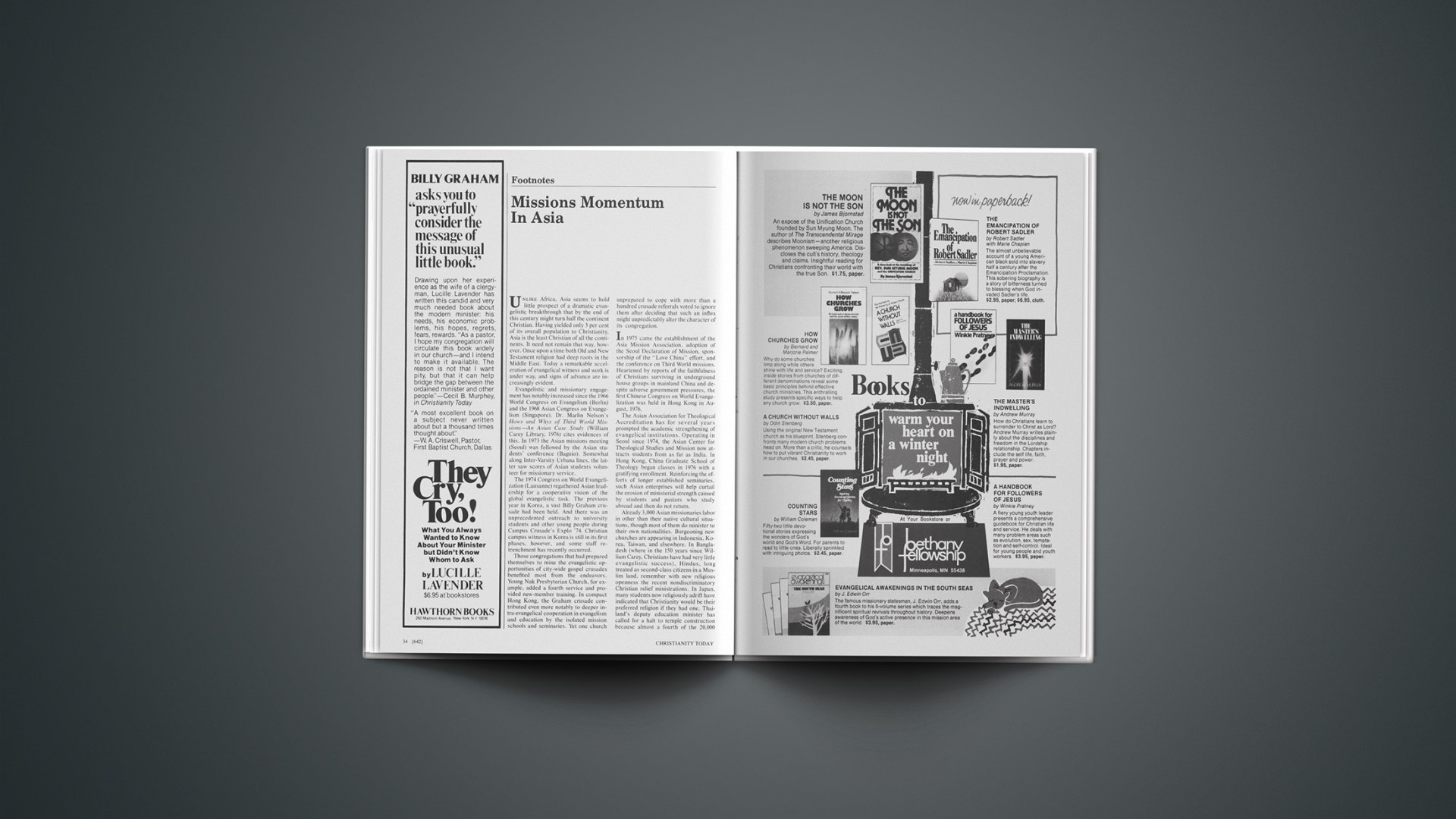Unlike Africa, Asia seems to hold little prospect of a dramatic evangelistic breakthrough that by the end of this century might turn half the continent Christian. Having yielded only 3 per cent of its overall population to Christianity, Asia is the least Christian of all the continents. It need not remain that way, however. Once upon a time both Old and New Testament religion had deep roots in the Middle East. Today a remarkable acceleration of evangelical witness and work is under way, and signs of advance are increasingly evident.
Evangelistic and missionary engagement has notably increased since the 1966 World Congress on Evangelism (Berlin) and the 1968 Asian Congress on Evangelism (Singapore). Dr. Marlin Nelson’s Hows and Whys of Third World Missions—An Asian Case Study (William Carey Library, 1976) cites evidences of this. In 1973 the Asian missions meeting (Seoul) was followed by the Asian students’ conference (Baguio). Somewhat along Inter-Varsity Urbana lines, the latter saw scores of Asian students volunteer for missionary service.
The 1974 Congress on World Evangelization (Lausanne) regathered Asian leadership for a cooperative vision of the global evangelistic task. The previous year in Korea, a vast Billy Graham crusade had been held. And there was an unprecedented outreach to university students and other young people during Campus Crusade’s Explo ’74. Christian campus witness in Korea is still in its first phases, however, and some staff retrenchment has recently occurred.
Those congregations that had prepared themselves to mine the evangelistic opportunities of city-wide gospel crusades benefited most from the endeavors. Young Nak Presbyterian Church, for example, added a fourth service and provided new-member training. In compact Hong Kong, the Graham crusade contributed even more notably to deeper intra-evangelical cooperation in evangelism and education by the isolated mission schools and seminaries. Yet one church unprepared to cope with more than a hundred crusade referrals voted to ignore them after deciding that such an influx might unpredictably alter the character of its congregation.
In 1975 came the establishment of the Asia Mission Association, adoption of the Seoul Declaration of Mission, sponsorship of the “Love China” effort, and the conference on Third World missions. Heartened by reports of the faithfulness of Christians surviving in underground house groups in mainland China and despite adverse government pressures, the first Chinese Congress on World Evangelization was held in Hong Kong in August, 1976.
The Asian Association for Theological Accreditation has for several years prompted the academic strengthening of evangelical institutions. Operating in Seoul since 1974, the Asian Center for Theological Studies and Mission now attracts students from as far as India. In Hong Kong, China Graduate School of Theology began classes in 1976 with a gratifying enrollment. Reinforcing the efforts of longer established seminaries, such Asian enterprises will help curtail the erosion of ministerial strength caused by students and pastors who study abroad and then do not return.
Already 3,000 Asian missionaries labor in other than their native cultural situations, though most of them do minister to their own nationalities. Burgeoning new churches are appearing in Indonesia, Korea, Taiwan, and elsewhere. In Bangladesh (where in the 150 years since William Carey, Christians have had very little evangelistic success), Hindus, long treated as second-class citizens in a Muslim land, remember with new religious openness the recent nondiscriminatory Christian relief ministrations. In Japan, many students now religiously adrift have indicated that Christianity would be their preferred religion if they had one. Thailand’s deputy education minister has called for a halt to temple construction because almost a fourth of the 20,000 Buddhist temples are virtually deserted except for a few priests.
While still growing, Korea’s 16,000-member Young Nak Presbyterian Church is no longer that country’s largest congregation. With 26,000 members who throng the 8,000-seat auditorium in four Sunday services, the somewhat atypical Assembly of God (First) Church just outside Seoul is thriving. Its charismatic emphasis—including exorcism, which connects with the animistic background of many Koreans—has won a wide hearing. The large number of converts to Christianity in the Korean army continues; last year almost 20,000 servicemen were baptized. After nine years’ work by scholars, the Korean Bible Society is issuing its first new translation in forty years.
Korea’s 2.7 million Christians are adding to their ranks at four times the population growth. Mostly evangelical Protestant, they now make up 16 per cent of the total population. While divided into four major and four minor camps, Presbyterians alone number more than 1.6 million; Methodists more than 350,000; the Korean Evangelical Church (O.M.S.) 240,000; Assemblies of God 100,000; and Baptists 70,000. Over three years the Korean Evangelical Church has established 200 new congregations (a new church every week); its special days of witness and active crusade teams have added 40,000 more church members to a constituency of 200,000. Awaiting availability of their own seminary trainees, some Korean churches have begun interim support of non-Korean missionaries even in lands as distant as Brazil.
The concentration of churches in big urban centers like Seoul and Pusan is being supplemented by extension churches in unevangelized suburban and rural areas. In five years Presbyterians established, for example, a satellite area church of 500 members, and Baptists in four years established one of 400 members and a Sunday school of 600. (Some of this is transfer growth, however.) Korean Christians gather in neighborhood house meetings on Friday, in addition to midweek and Sunday services.
Despite its growth, Korean Christianity is not without problems. Long-established evangelical colleges and universities tend under secular pressures to become Christian in heritage and mood more than in perspective and intellectual commitment. Theologically the seminaries remain predominantly conservative; pockets of neo-orthodoxy and liberalism are the exception. But evangelicals there as everywhere often exploit their differences for promotional and financial advantage, thus sacrificing large areas of potential cooperation and economy at a time when a unified impact would count for much on both intellectual and evangelistic frontiers.










